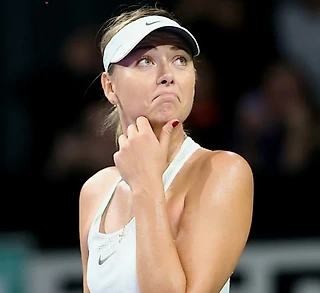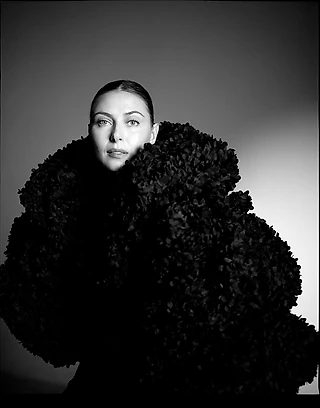Maria Sharapova to discover length of ban at anti-doping panel in London
• Sharapova tested positive for meldonium at Australian Open in January
• Ban of between six and 12 months expected, well under four-year maximum
Press Association
Tuesday 17 May 2016 18.58 BST Last modified on Tuesday 17 May 2016 19.14 BST
Maria Sharapova faces an anti-doping panel in London on Wednesday knowing she will not benefit from recent confusion surrounding the drug she tested positive for in January.
The 29-year-old Russian stunned the tennis world in March when she announced at a press conference that she had failed a test for meldonium on 26 January, the day she lost an Australian Open quarter-final to Serena Williams.
The Latvian-made heart disease medication had only been added to the World Anti-Doping Agency’s banned list on 1 January but had been on a watch list for over a year and all national anti-doping agencies were told in October that it would be banned.
With use of meldonium widespread across eastern Europe, Sharapova’s case was the most high-profile in an avalanche of positives in the first four months of the year. As of early May, Wada said there had been 288 positive samples.
But in April the agency was forced to make an embarrassing climbdown when it admitted there was a lack of scientific certainty on how long it takes for the drug to be completely excreted.
Early suggestions that it should be out of an athlete’s system within days gave way to fears it could be present in long-term users, in trace amounts, for weeks, if not months.
This led Wada to issue new guidance, directing that samples collected before 1 March below a certain concentration of meldonium could be discarded, as the athlete might be able to prove they had stopped taking it in 2015.
Last month the Belarusian doubles specialist Sergey Betov, who also tested positive at the Australian Open, was cleared by the International Tennis Federation on these grounds.
This prompted some to speculate that Sharapova, a five-time grand slam winner, could escape without punishment, which was always mistaken as both she and her lawyer John Haggerty had already admitted she had been taking it, on her doctor’s advice, throughout January.
This was underlined by the Russian sports minister, Vitaly Mutko, last month, when he told the Russian news agency Tass that the concentration of meldonium in Sharapova’s system was above the provisional limit.
Sharapova, instead, must try to convince an International Tennis Federation panel that the “laundry list” of health reasons that Haggerty referred to in March should qualify her for a backdated therapeutic use exemption (Tue), or sick note.
Whether this will be enough to enable the world’s highest-earning female athlete to avoid any ban at all is highly debatable, as all athletes sign up to the principle of strict liability and Tues should be arranged, and independently verified, in advance.
The maximum punishment available is four years but most anti-doping experts think a more likely ban is between six and 12 months, which would start from the date of her provisional suspension on 12 March, so even a ban at the lenient end of that range would lead to Sharapova missing the remaining grand slams this season, including Wimbledon, and the Rio Olympics.
https://www.theguardian.com/sport/2016/may/17/maria-sharapova-anti-doping-panel-london
>









Но просто вы опять забивайте - да, со всех сняли отстранение из за рекомендации ВАДА но только у Марии кажется выше 1го , как не думать что всё это специально против нее устроенно и придумано? появление правила который спасает всех кроме нее , как?
всё что сказала Маша на ПК или делают ее адвокаты сейчас не важно потому что еслиб у нее было тоже ниже 1го без проблем ее адвокаты добились бы снятия отстранения .. НО ее концентрация ВСЕ усложнило и эти рекомендации для нее нечего не изменило
Накажут только ее? ВСЕХ амнистируют а ее накажут ? как поверить в это? не бывает допинга - мало или много , он или есть или нет ... Нонсенс какой то ...
Все говорят какие ее люди профи своего дела и сильные вот выйдет вердикт и посмотрим кто они на самом деле !!!!!
__________________________________________________________________________________________
Повторяю в 1001 раз, СМИ, которые ссылаются на слова Мутко, то уверяю Вас не говорил он ни о каких Запредельных показателях. Его слова о концентрации : "Немножко выше допустимой нормы". Тарпищев же сначала сказал, что знает, но не скажет, но на днях в интервью сказал, что не в курсе Машиной концентрации. А сама Маша в обращении акцентировала на том, что принимала малыми дозами по рекомендации врача. Кстати, мельдоний обладает свойством накапливаться.
Они имеют в виду, что завтра начинается Трибунал и в конце дня Мария узнает решению Трибунала.
Они тоже спрашивали разных экспертов какое наказание можно ожидать и большинство сказали от 6 до 12 месяцев.
Не забывайте, что из другого источника мы знаем что заседания Трибунала будут завтра и после завтра.
Поэтому нельзя верить 100%, все это журналистическая информация.
Но с другой стороны хорошо, что никто не думает о наказание больше года.
То есть общественное мнение подготовлено принять небольшое наказание Марии.
____________________________
Всё время удивляюсь, откуда такие инфо берёте ? #Faceplam